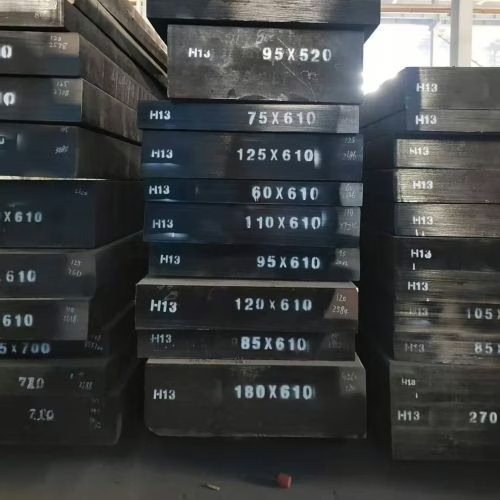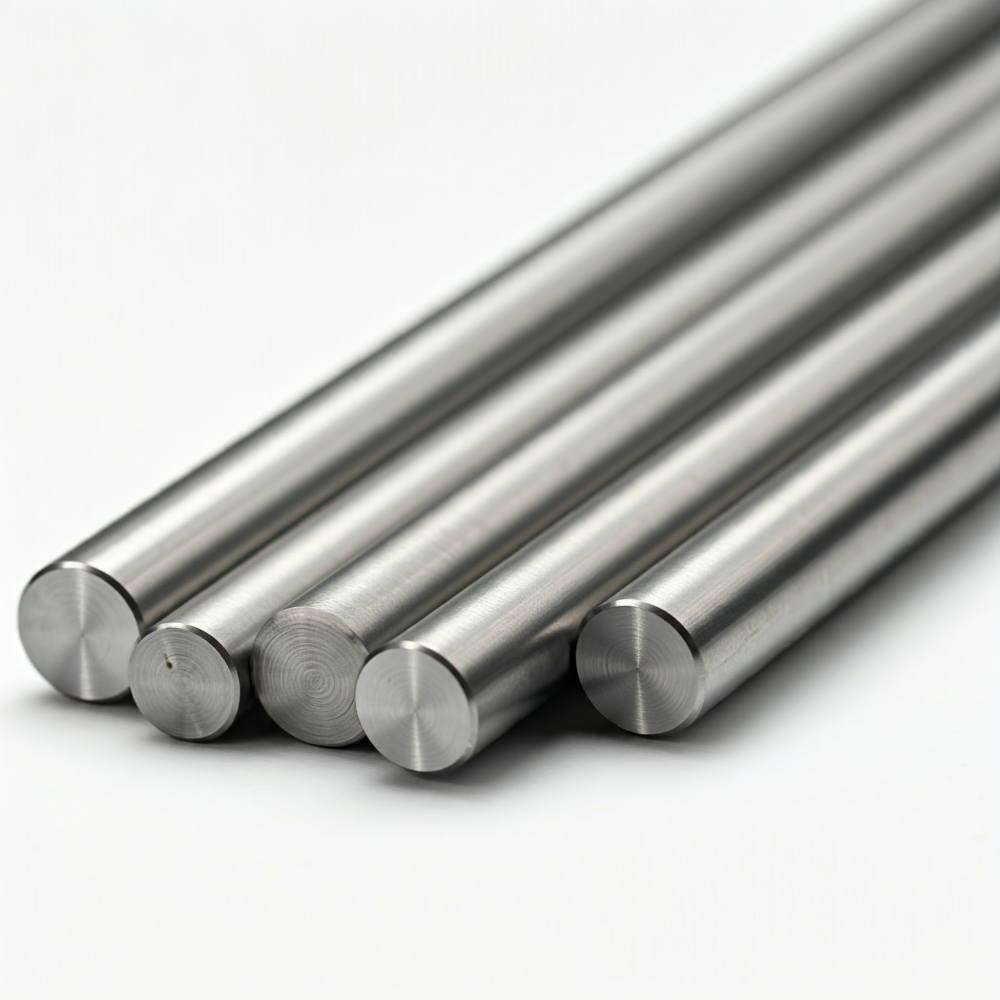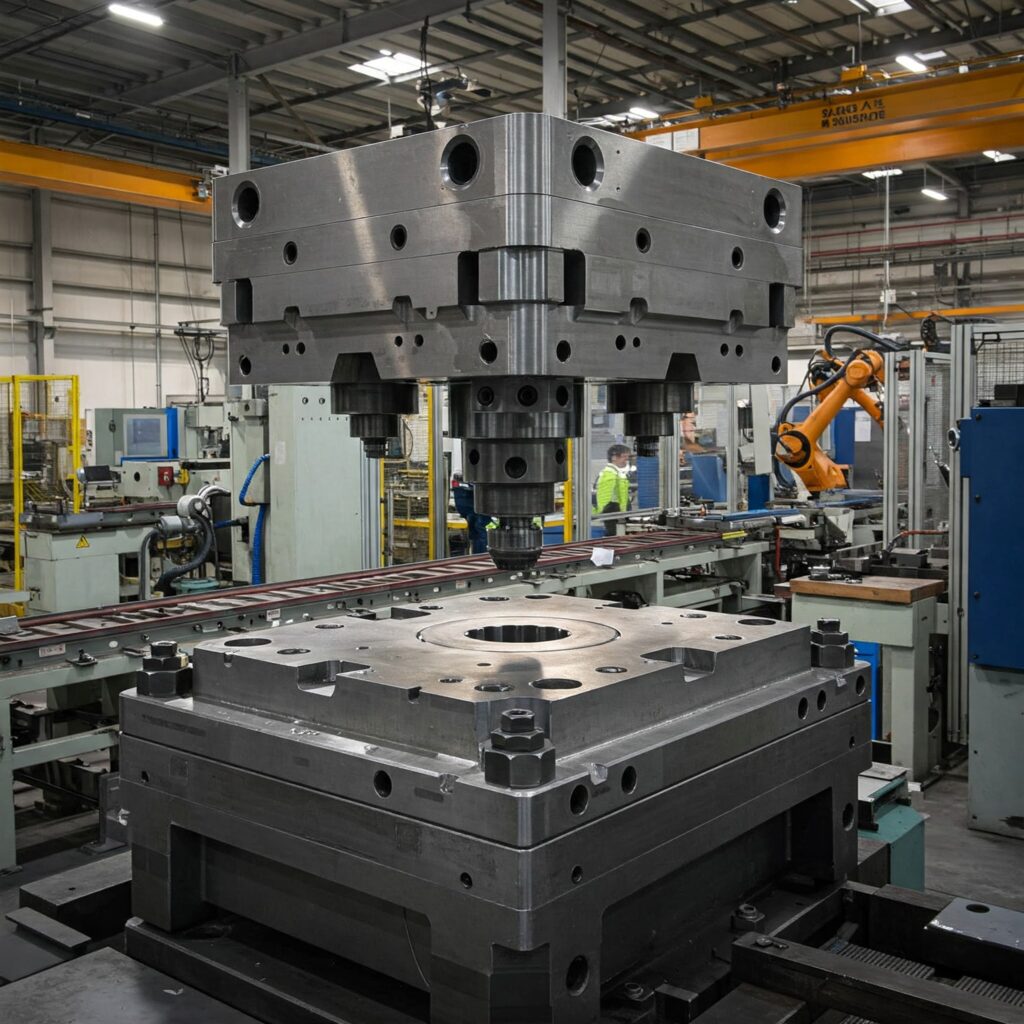Estimated reading time: 6 minutes
Key Takeaways
- H13 Steel Composition includes around 5% chromium, 0.40% carbon, and significant molybdenum and vanadium for enhanced strength and wear resistance.
- H13 acts as a medium-carbon hot-work die steel, classified under various international standards including AISI/ASTM and UNS.
- The composition enables exceptional red hardness, toughness, and wear resistance, making H13 the preferred choice for die-casting and forging applications.
- Electro-Slag Remelting (ESR) enhances H13 by removing impurities and ensuring a uniform distribution of alloying elements, resulting in superior toughness.
- The steel excels in high-temperature applications like aluminum die casting and plastic injection molds, especially when ESR refined.
Table of contents
H13 steel ranks among the most widely used and versatile hot-work tool steels globally, primarily due to its meticulously engineered chemical composition. Designed for extreme conditions, H13 material delivers exceptional reliability even under demanding environments of high temperatures and high stresses. This guide delves into the microscopic chemical world of H13 steel, explaining how its primary alloying elements synergize to impart this steel with its unique performance advantages.
Defining H13: Designations and Classification
H13 is a typical 5% chromium hot-work die steel, classified within the H10-H19 chromium hot-work steel series. Its yield strength easily exceeds 1380 MPa (200 ksi), making it a medium-alloy ultra-high-strength steel in industrial applications. It not only resists heat but also exhibits exceptional resistance to deformation. H13 is an air-hardening steel that exhibits excellent deep hardenability. Even large-sized, thick-section mold materials achieve uniform hardness solely through air cooling. Compared to oil- or water-quenched steels, air cooling significantly reduces residual stresses after heat treatment, minimizing the risk of mold cracking and deformation.
Several designations across international standards are known as H13:
| Standard System | Grade / Designation | Expert Remarks |
| AISI / ASTM (USA) | H13 | The most universally used designation globally. |
| UNS (Unified Numbering) | T20813 | North American industrial unified numbering. |
| EN / DIN (Europe/Germany) | X40CrMoV5-1 (Mat. No. 1.2344) | “X40” represents a carbon content of approx. 0.40%; suffixes indicate the addition of Chromium (Cr), Molybdenum (Mo), and Vanadium (V). |
| GB (China) | 4Cr5MoSiV1 | The most commonly used standard for hot work mold steel domestically in China. |
| JIS (Japan) | SKD 61 | Standard designation in the Japanese mold industry. |

The composition ranges for H13 (AISI/ASTM A 681-94) in weight percent are typically:
| Element | Range (wt%) | Typical Value (wt%) | Function Category |
| Carbon (C) | 0.32 – 0.45 | 0.40 | Martensite former, Carbide former |
| Silicon (Si) | 0.80 – 1.25 | 1.0 | Solid solution strengthener, Alpha former |
| Manganese (Mn) | 0.20 – 0.60 | 0.3 | Promotes sound structures, Hardenability |
| Chromium (Cr) | 4.75 – 5.50 | 5.0 | Carbide former, Secondary hardening, Alpha former |
| Molybdenum (Mo) | 1.10 – 1.75 | 1.3 | Carbide former, Secondary hardening, Alpha former |
| Vanadium (V) | 0.80 – 1.20 | 0.9–1.0 | Strong Carbide former, Wear resistance |
| Phosphorus (P) | ≤ 0.030 | — | Impurity (Limited) |
| Sulfur (S) | ≤ 0.030 | — | Impurity (Limited) |
| Nickel + Copper | ≤ 0.75 | — | Other limits |
Role of Essential Alloying Elements in H13 Composition
The properties of H13 are directly linked to the synergistic effects of these alloying elements and subsequent H13 steel heat treatment.
1. Carbon(C)
Carbon content is the cornerstone of steel strength. H13 is defined as medium-carbon steel (approximately 0.40% carbon), a value not arbitrarily chosen. A carbon content of 0.40% is essential for forming a hard martensitic matrix. Carbon content controls the volume fraction of martensite, thereby fundamentally determining the steel’s base strength.
2. Chromium (Cr)
H13 steel, with approximately 5% chromium content, not only prevents rust but also enables H13 to effectively resist liquid aluminum corrosion. This is precisely why H13 is the preferred choice for aluminum die casting molds. Additionally, during the tempering process, chromium-rich M23C6 carbides precipitate, producing a secondary hardening effect.
3. Molybdenum (Mo)
Molybdenum is a strong carbide-forming element that significantly enhances steel’s hardenability, ensuring consistent hardness throughout large mold sections, from the surface to the core. The synergy between molybdenum and chromium endows H13 with an exceptionally flat tempering curve, enabling it to maintain high strength and hardness even after high-temperature tempering.
4. Vanadium (V)
This is where H11 and H13 differ. Their base compositions are very similar, but H13 has a higher vanadium content. H13 contains 0.80-1.20%, while H11 contains only 0.30-0.60%. The high vanadium content forms fine, uniformly distributed hard vanadium carbides (V-rich MC / V8C7). These vanadium carbides are considered the primary strengthening phase. Acting like an aggregate in concrete, they significantly enhance the material’s wear resistance. This is the fundamental reason H13 exhibits superior wear resistance compared to H11.
5. Silicon (Si) and Manganese (Mn)
Although these two elements are not the main protagonists, they are crucial to the fundamental quality of steel. Silicon (Si) content typically ranges between 0.80% and 1.25%. Its primary function is to provide a solution that strengthens and enhances the strength of the matrix. Manganese (Mn) promotes the soundness of the steel’s internal structure, reduces brittleness, and simultaneously aids in increasing the depth and rate of quenching.
Compositional Impact on H13 Steel‘s Microstructure
H13 is secondary hardening steel. During the quenching stage, most carbides dissolve into the matrix. During tempering, three uniform nanoscale carbides are uniformly dispersed throughout the martensitic matrix: vanadium-rich MC carbides, molybdenum-rich M6C carbides, and chromium-rich M23C6 carbides. Among these, MC and M6C particles are typically extremely fine, often smaller than 200 nm. This dispersed distribution of fine particles impedes dislocation motion, thereby enhancing the strength of H13 steel.
Electro-Slag Remelting (ESR)-Enhancing H13 Composition through Refining
ESR-refined H13 steel (H13 ESR) is a high-purity, high-density material. Compared to conventional cast and forged steels, the ESR process achieves a qualitative leap through secondary remelting and purification. ESR significantly removes harmful impurities (such as sulfur and phosphorus) and non-metallic inclusions from the steel. It ensures uniform distribution of alloying elements, resulting in superior structural homogeneity, reduced compositional segregation, and eliminates “banding” or “clumping” formed by carbide aggregation during solidification.
ESR-treated H13 steel exhibits enhanced toughness and superior resistance to mechanical fatigue, enabling high-gloss polishing. When producing plastic parts with a mirror finish, ESR-grade H13 is essential. Minor impurities or carbide clusters in standard H13 steel can cause pinholes or “orange peel” during polishing, preventing the achievement of mirror-like requirements.
Key Applications Driven by H13’s Composition
The alloy composition of H13 steel endows it with three key characteristics: red hardness, toughness, and wear resistance.
In the hot-work die field, H13 stands as the undisputed benchmark product and the most widely used general-purpose hot-work die steel.
Its core application lies in die-casting molds, particularly for aluminum, zinc, and magnesium alloys, where it withstands repeated exposure to high-temperature molten metal. It also serves as the primary choice in hot extrusion and forging applications.
Beyond high-temperature metal forming, H13 finds applications in plastic injection molds where high hardness and exceptional high-gloss polishing performance are required. It excels in these roles, especially when ESR refined.
Finally, owing to its outstanding high-temperature strength and resistance to softening, H13 is also employed in manufacturing ultra-high-strength structural components.


